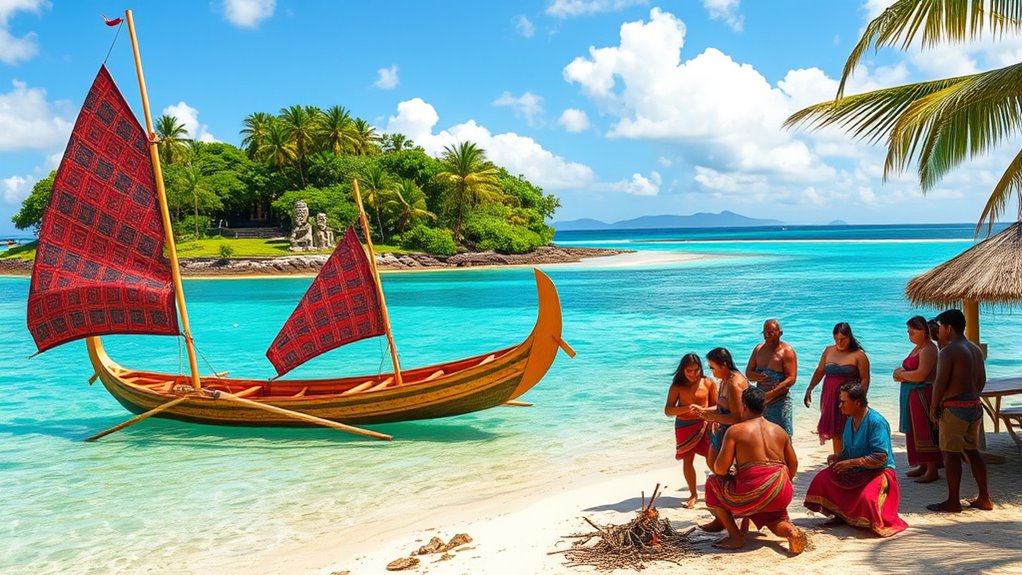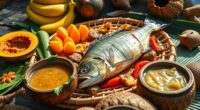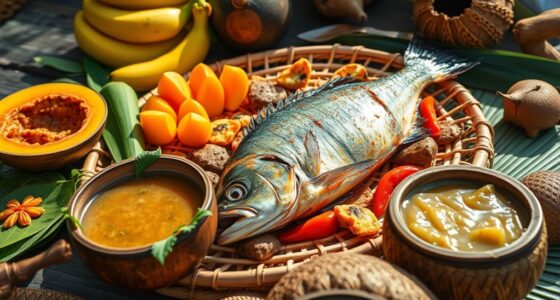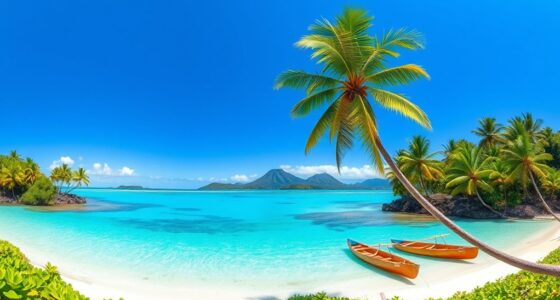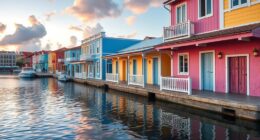Micronesia’s history spans over 4,000 years, starting with Austronesian sailors who traveled across vast oceans using advanced navigation and boat-building skills. Its diverse cultures are marked by vibrant arts, traditional practices, and enduring languages despite colonization by Europeans and others. Today, Micronesian nations celebrate their heritage through crafts, storytelling, and festivals, while facing environmental challenges. If you explore further, you’ll discover the resilience and rich traditions that define this fascinating region.
Key Takeaways
- Micronesia’s history traces back over 4,000 years with Austronesian migration, maritime exploration, and complex inter-island networks.
- Traditional navigation skills, using stars, currents, and environmental cues, enabled extensive Pacific exploration and cultural exchange.
- Colonial influences from Spain, Germany, Japan, and the U.S. have shaped Micronesian political development and cultural identity.
- Rich cultural heritage includes latte stones, woodcarving, weaving, music, and storytelling, preserving traditional practices amid modern influences.
- Environmental challenges like rising sea levels and natural disasters threaten Micronesian land and cultural preservation efforts.
The Dawn of Human Settlement in Micronesia

Human settlement in Micronesia began over 4,000 years ago when Austronesian ancestors migrated from pre-Han Formosa between 3000 and 1500 BCE. You can imagine them voyaging across vast ocean distances using sophisticated sailing technologies like catamarans, outrigger boats, and crab claw sails. As they spread across the Pacific, they reached the northernmost Philippines, including the Batanes Islands, by roughly 2200 BCE. These early settlers were skilled navigators, relying on celestial cues, currents, bird flight patterns, and cloud formations to guide them. During this migration, they also assimilated with earlier island populations, creating diverse cultures. Their mastery of the seas and adaptation to island life laid the foundation for the rich and complex societies that would develop across Micronesia. Navigation techniques played a crucial role in ensuring their successful voyages across the open ocean.

The remarkable maritime skills of Micronesian ancestors powered their expansive voyaging across the Pacific. You can imagine how they built sophisticated boats like double-hulled canoes, outriggers, and crab claw sails, allowing swift, reliable travel over open waters. Using celestial navigation, they tracked stars, currents, and weather patterns to find their way between islands. Their knowledge of the ocean was so precise that they settled islands over 2,000 miles apart, from the Philippines to Polynesia. These navigators played a crucial role in spreading Austronesian languages, technologies, and cultural practices across the Pacific. Their mastery of oceanic navigation enabled them to explore, settle, and maintain vibrant networks of inter-island contact, forming the foundation of Micronesian culture and identity. Modern navigational methods have evolved from these ancient techniques, yet the core principles remain rooted in their traditional oceanic knowledge.
First Encounters: European Contact and Colonial Legacies
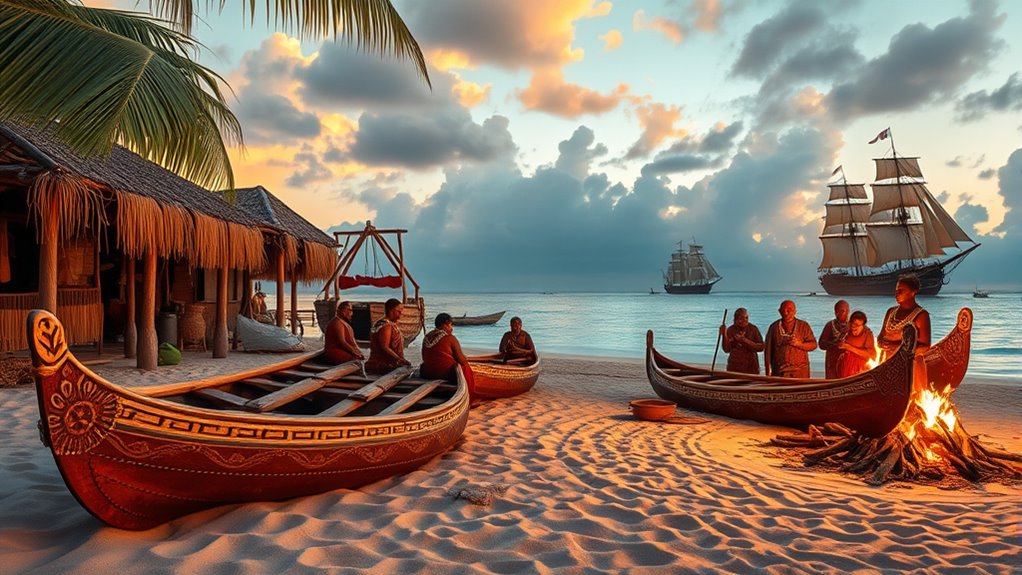
European contact with Micronesia began in 1521 when Ferdinand Magellan arrived on Guam, marking the start of a series of explorations that would dramatically alter the region’s history. Soon after, Spain established control over the Marianas in 1668, forcing cultural changes and causing population decline among the Chamorro people through conflict, disease, and relocations. Over the next centuries, other powers, including Germany, Britain, Japan, and the United States, claimed various islands, leaving lasting colonial legacies. German rule in the early 1900s documented Micronesian arts but also suppressed traditions. Japanese colonization later eroded cultural practices further. After World War II, the U.S. administered Micronesia under a UN trusteeship, shaping the political and social landscape that influenced independence movements and regional identities today.
Shaping Nations: Political Evolution and Independence
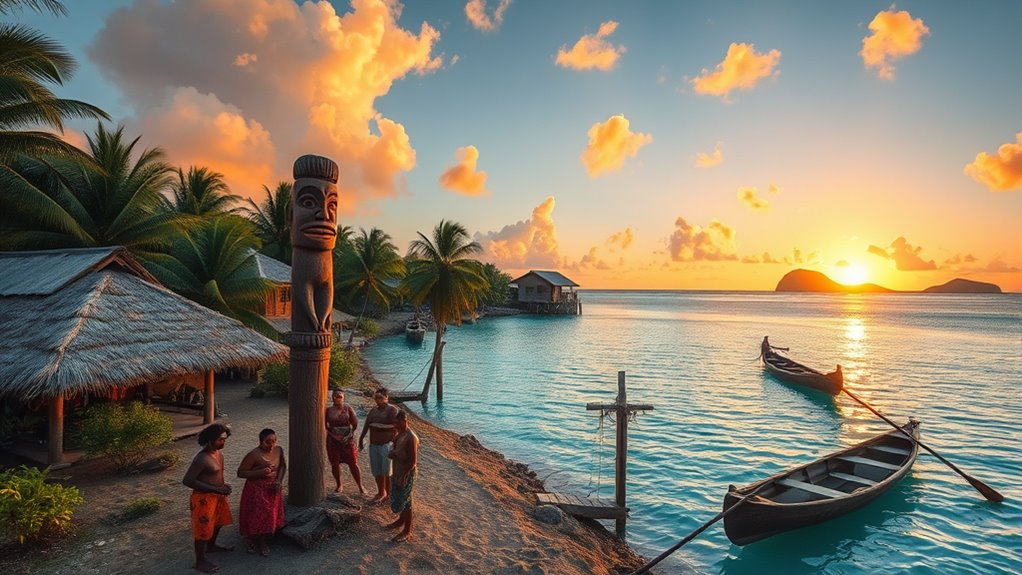
Micronesian nations have undergone a complex political evolution driven by colonial legacies and regional aspirations for independence. You’ve seen how each island’s governance shifted under European and Asian powers, shaping their political identities. Post-World War II, the United States administered many islands through trusteeships, laying the groundwork for independence. Nauru became the first independent Micronesian nation in 1968, followed by Kiribati in 1979, with others like the Federated States of Micronesia gaining sovereignty later. Despite gaining independence, these nations maintain strong cultural ties and regional cooperation. Their political systems evolved from decentralized chieftainships to centralized governments, often influenced by international agreements. Today, they face challenges like geographic vulnerabilities, but their ongoing pursuit of sovereignty underscores their resilience and desire for self-determination. The influence of international agreements has significantly shaped their political development and ongoing diplomatic relations.
Cultural Heritage: Traditional Practices and Architectural Marvels
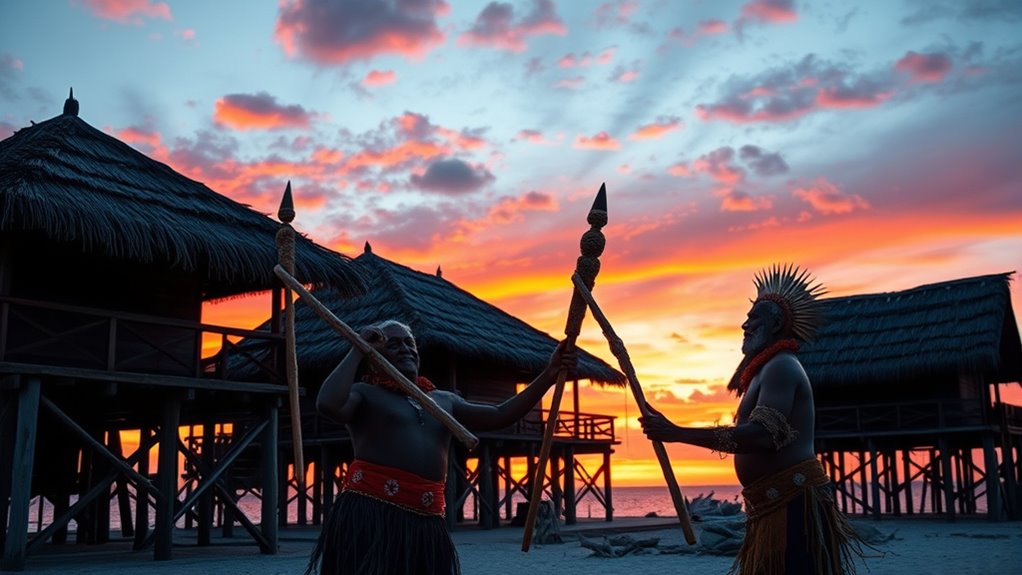
Traditional practices and architectural marvels in Micronesia showcase a rich cultural legacy rooted in ingenuity and respect for the environment. You’ll notice the iconic *latte* stones in Chamorro villages, which served as sturdy foundations for buildings and symbolize ancestral strength. These stones were carefully crafted and placed, demonstrating advanced engineering skills. Agriculture, especially rice cultivation in the Marianas, highlights innovative farming adapted to island conditions and trade networks. You’ll also find vibrant woodcarvings and storyboards from Belau, depicting legends and cultural narratives. Many practices, such as navigational techniques using stars, currents, and clouds, still honor traditional knowledge. These enduring elements reflect a deep connection to the land, sea, and ancestors, preserving Micronesia’s unique identity amid changing times. Additionally, cultural preservation efforts continue to keep these traditions alive for future generations.
Languages and Ethnic Diversity in Micronesia
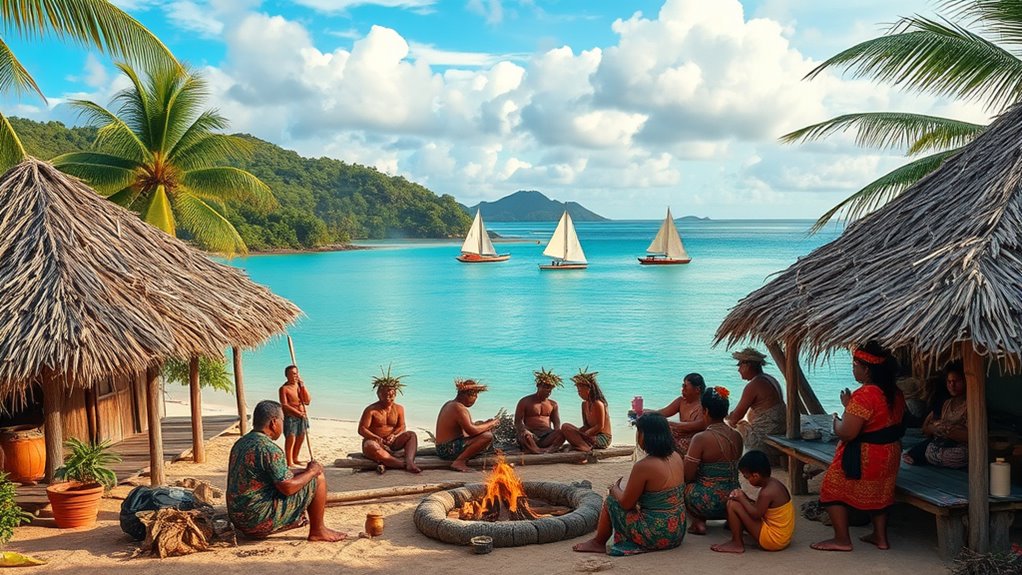
You’ll notice that Micronesia isn’t one unified culture but a collection of diverse groups with distinct languages and traditions. While many peoples speak Austronesian languages, there are significant ethnic differences that shape their identities. These variations influence cultural practices and how communities see themselves within the broader region. Cultural diversity is a key feature of Micronesia, reflecting its complex history and the range of influences from neighboring regions.
Diverse Language Families
The region’s linguistic landscape is as diverse as its islands, reflecting a complex tapestry of ethnic groups and historical influences. You’ll find that Micronesia hosts multiple language families, primarily Austronesian languages, which dominate the region. These languages spread across numerous islands, each with unique dialects that evolved over centuries. Some islands also have languages with possible Melanesian roots, adding to the diversity. Despite colonial disruptions, many communities continue to speak their ancestral tongues, preserving their cultural identity. You’ll notice that language plays a essential role in maintaining social ties, traditions, and navigation skills. This linguistic variety highlights how the Micronesian peoples adapted to their environment, fostering distinct identities while sharing common maritime heritage.
Ethnic Group Variations
Micronesia’s diverse ethnic groups and languages reflect the complex history of migration, trade, and cultural exchange across the islands. You’ll find a mosaic of peoples, each with distinct origins and traditions. The Chamorro, with their unique language and customs, have deep roots in the Marianas, maintaining their identity despite colonial disruptions. Meanwhile, the Caroline Islanders, including Palauans and Yapese, share linguistic ties within the Austronesian family, yet each community boasts its own dialects and social practices. Nauruans and Kiribatians also contribute to this tapestry, often tracing descent matrilineally. Across Micronesia, these groups emphasize their oceanic heritage, celebrating navigation and seafaring skills that fostered interactions long before European contact. The region’s linguistic diversity is a testament to its rich history of migration and cultural resilience, highlighting how language has played a key role in preserving individual identities amidst widespread change. This ethnic and linguistic diversity underscores the region’s vibrant, layered history of movement and adaptation.
Cultural Identity Factors
Despite sharing a common maritime environment, the diverse languages and ethnic groups across Micronesia define its rich cultural landscape. You’ll notice that no single language unifies the region; instead, hundreds of dialects and languages flourish, reflecting distinct island identities. Many Micronesian peoples belong to Austronesian-speaking groups, but influences from Polynesian and Melanesian cultures also shape their traditions. The Chamorro language persists despite colonization, symbolizing resilience. Ethnic identities are often linked to specific islands, with descent traced matrilineally in some societies. Navigation skills, oral histories, and traditional practices reinforce a strong sense of cultural identity rooted in the ocean and land. This diversity fosters a complex tapestry of histories, languages, and customs, making Micronesia’s cultural identity deeply rooted yet remarkably adaptable. Additionally, the region’s language diversity is supported by its geographical isolation, which has helped preserve unique dialects and cultural practices over centuries.
Maritime Traditions and Navigational Mastery
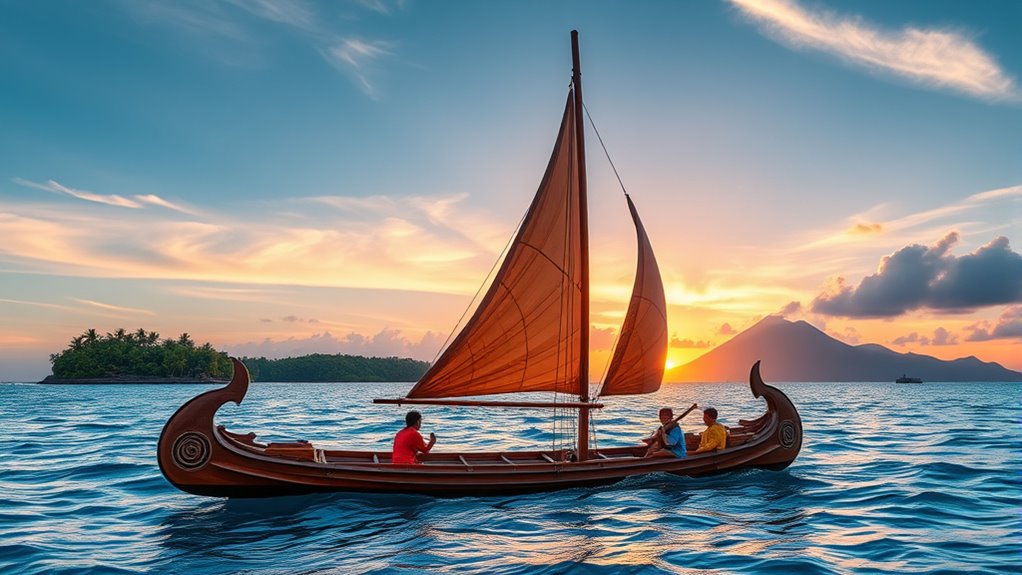
Maritime traditions and navigational mastery are at the heart of Micronesian culture, reflecting centuries of skillful oceanic exploration. You learn to read the stars, currents, and clouds to find your way across vast distances without GPS. Micronesians built specialized boats like outrigger canoes and crab claw sails, enabling swift, accurate travel. Their navigation techniques relied on subtle environmental cues, passed down through generations. These skills shaped their societies, allowing for trade, communication, and cultural exchange across islands. Your ancestors’ mastery of the sea kept Micronesian communities connected, resilient, and self-sufficient. This maritime expertise embodies a deep understanding of the ocean, demonstrating their extraordinary navigational ingenuity and enduring bond to the waters surrounding their islands.
| Skill or Tool | Purpose |
|---|---|
| Outrigger canoes | Stability and speed |
| Celestial navigation | Finding directions by stars |
| Currents and clouds | Detecting ocean patterns |
| Crab claw sails | Catching the wind efficiently |
Environmental Challenges and Geographic Influences
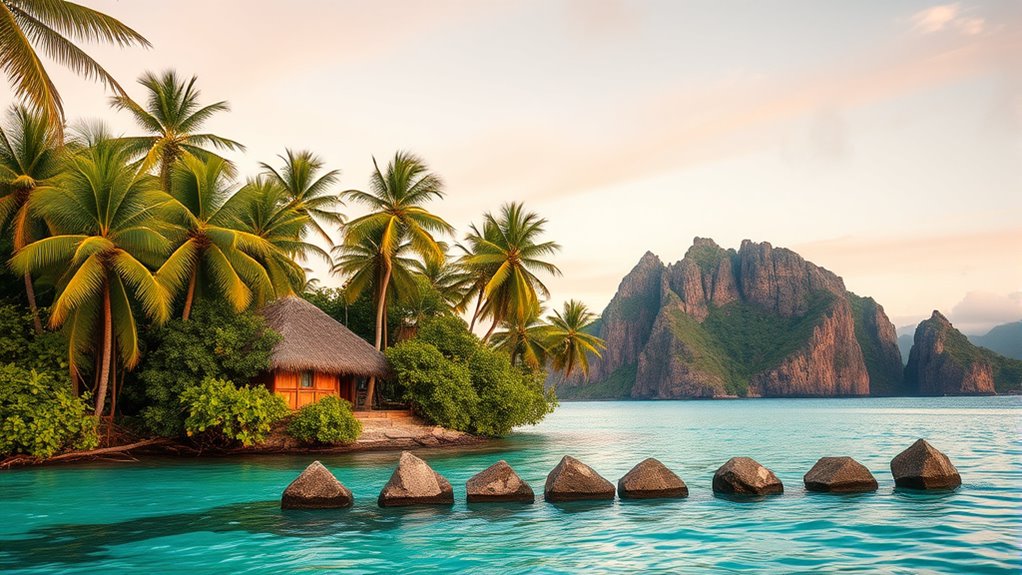
The same skills that allowed Micronesian navigators to traverse vast ocean distances are now tested by the region’s environmental challenges. You face limited land space, which constrains population growth and development. Droughts threaten water supplies, forcing communities to adapt traditional water management methods. Repeated tropical cyclones cause destruction, disrupting homes, agriculture, and infrastructure. Low coral atolls are especially vulnerable to rising sea levels, risking erosion and loss of land. These geographic features compel you to develop high mobility and extensive inter-island exchange networks to survive. Your cultural resilience and maritime expertise help you cope with these threats, but climate change and environmental degradation continue to pose significant risks to your islands’ future stability and way of life. Incorporating diverse designs in your infrastructure can help communities adapt to changing environmental conditions and foster sustainable development.
Art, Storytelling, and Cultural Expressions

Have you ever wondered how Micronesian communities preserve their rich cultural identities through art and storytelling? You’ll find that storytelling remains an essential tradition, passed down orally through generations. Legends, myths, and historical tales are shared during gatherings, often accompanied by chants or songs that reinforce cultural values. Artistic expressions like woodcarving, weaving, and tattooing highlight unique designs and symbols, each telling a story or marking social status. In places like Belau, woodcarving art forms such as storyboards depict traditional legends visually. Architecture also reflects cultural expression, with structures like latte stones symbolizing community strength. Additionally, candle-making techniques can serve as a metaphor for cultural preservation, as they involve traditional skills and creative expression that are handed down through generations. These practices embed history and beliefs into daily life, ensuring that, despite external influences, Micronesia’s cultural identity continues to thrive through vibrant art and storytelling.
Contemporary Life and Preservation of Heritage
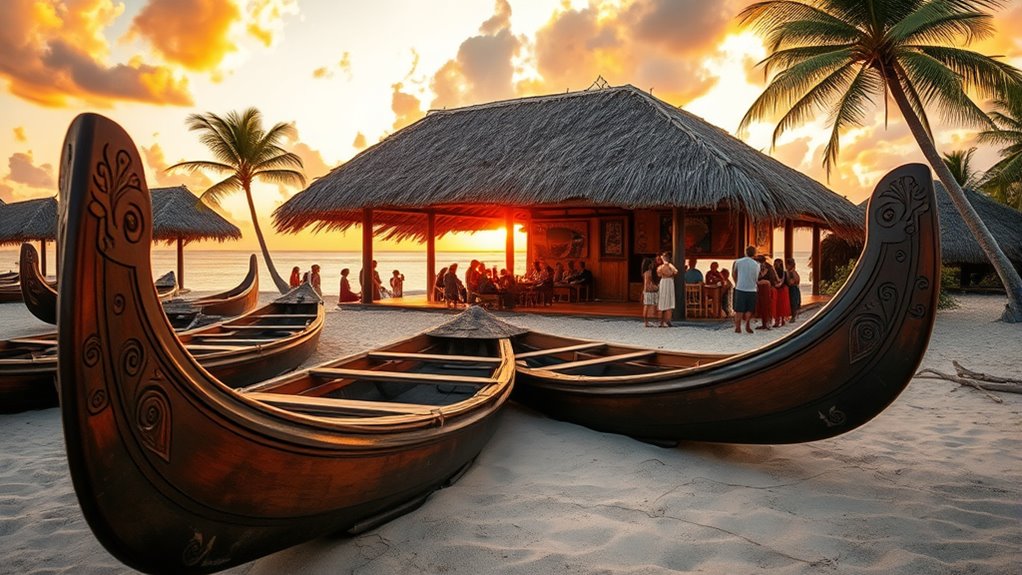
You can see how Micronesian communities actively work to preserve their heritage through cultural programs and language revitalization projects. Contemporary artists incorporate traditional motifs into new works, keeping their artistic expressions alive. These efforts help maintain a strong connection to their history while adapting to modern life. Additionally, community-led initiatives utilize data analytics to identify areas where cultural engagement can be strengthened.
Cultural Preservation Efforts
Amid modern challenges, Micronesian communities actively pursue efforts to preserve their rich cultural heritage. You can see this in various initiatives aimed at maintaining traditions, arts, and history.
- Local organizations promote traditional crafts like woodcarving, weaving, and tattooing, ensuring skills are passed down.
- Cultural festivals celebrate stories, dance, and music, helping younger generations connect with their roots.
- Governments and NGOs support heritage sites, like ancient latte stone structures, to protect historical landmarks.
These efforts foster pride and continuity, despite pressures from globalization and climate change. Your involvement, whether through education or community events, helps keep Micronesia’s unique culture alive for future generations. It’s a essential part of their identity and resilience.
Language Revitalization Projects
Efforts to revitalize Micronesian languages are gaining momentum as communities recognize the importance of preserving their linguistic heritage. You can participate in local language classes, cultural workshops, and community events that focus on teaching traditional languages like Chamorro, Palauan, and Chuukese. Digital initiatives, such as creating language apps and online dictionaries, make learning accessible and engaging for younger generations. Schools are incorporating native languages into their curricula, fostering pride and identity. Oral storytelling is also encouraged to pass down traditional knowledge and vocabulary. These projects help combat language loss caused by historical colonization and modernization. By actively engaging in these efforts, you contribute to keeping Micronesian languages alive, ensuring future generations can connect with their roots and cultural identity.
Contemporary Artistic Expressions
Contemporary artistic expressions in Micronesia seamlessly blend traditional heritage with modern creativity, serving as essential tools for cultural preservation. You can explore how local artists incorporate ancient motifs into contemporary works, ensuring cultural stories endure. Here are three key examples:
- Woodcarving and Storytelling: Artists create modern wood sculptures and storyboards that depict traditional legends, maintaining a visual link to history.
- Textile Arts: Weaving and dyeing techniques are adapted into contemporary fabrics used in fashion and ceremonies, preserving ancestral patterns.
- Music and Dance: Traditional songs and dances are fused with modern genres, strengthening community identity and cultural pride.
These expressions keep Micronesian culture vibrant, engaging younger generations while honoring age-old traditions.
Frequently Asked Questions
How Did Austronesians Develop Their Advanced Oceangoing Sailing Technologies?
You see, Austronesians developed their advanced oceangoing sailing technologies through centuries of innovation and adaptation. They observed natural ocean patterns, learned celestial navigation using stars, and experimented with different boat designs like catamarans, outrigger boats, and crab claw sails. These innovations allowed them to travel quickly across vast distances, connect islands, and explore new territories, making them some of the best navigators in the ancient world.
What Were the Primary Impacts of European Colonization on Micronesian Cultures?
European colonization drastically disrupted Micronesian cultures, causing population declines, cultural erosion, and loss of traditions. You’d notice how indigenous societies faced conflict, disease, and displacement, weakening their social structures. Colonial powers like Spain, Germany, Japan, and the U.S. imposed their languages, religions, and governance, often suppressing local customs. Despite this, many cultural practices, languages, and identities persist today, demonstrating resilience amid colonial influence.
How Do Micronesian Societies Maintain Their Linguistic Diversity Today?
You keep Micronesian linguistic diversity alive by fiercely guarding your languages and passing them down through generations. Despite pressures from colonization and modernization, many communities still speak their native tongues at home and in cultural practices. Language revitalization programs and local education efforts act as the glue holding these languages together. It’s a case of not letting the grass grow under your feet, ensuring your rich heritage endures.
What Environmental Factors Most Threaten Micronesian Island Communities?
You face major environmental threats like rising sea levels caused by climate change, which threaten your island communities’ very existence. Droughts and limited freshwater resources make it hard to sustain agriculture and daily life. Tropical cyclones frequently hit, causing destruction and loss of life. Additionally, the fragile coral atolls are vulnerable to erosion and pollution, further endangering your environment and making it difficult to maintain your way of life.
How Are Traditional Navigation Skills Preserved Among Modern Micronesians?
Did you know that Micronesian navigators can read the stars with remarkable precision? You can preserve traditional navigation skills by practicing celestial navigation, using star maps, and sharing stories passed down through generations. Many communities still hold regular boat journeys and teach young people these techniques, ensuring they stay alive. Embracing modern technology alongside traditional methods helps keep these invaluable skills vibrant and relevant in today’s world.
Conclusion
As you explore Micronesia’s history and culture, you witness the lighthouse guiding its people through storms of change and echoes of ancient chants resonating like steady drums. The islands stand as symbols of resilience, their stories woven into every tide and tradition. By honoring these enduring symbols, you become part of a ongoing voyage—navigating the delicate balance between preserving the past and embracing the horizon’s promise.

